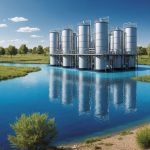Revolutionizing Water Purification: The Impact of Nanofilters on Modern Techniques
The Evolution of Water Treatment: From Traditional to Nanotechnology
Water treatment has come a long way from its traditional methods, which often involved simple physical and chemical processes. With the advent of nanotechnology, the field of water purification has seen a significant leap forward. Nanofilters, in particular, have emerged as a game-changer in modern water treatment techniques.
The Role of Nanotechnology in Water Purification
Nanotechnology involves the use of materials on a nanoscale, typically defined as 1 to 100 nanometers. These materials, such as nanoparticles, nanocomposites, and nanocatalysts, have unique physicochemical properties that make them highly effective in removing contaminants from water. For instance, their high chemical reactivity, thermal stability, and large specific surface area enable them to interact with and remove a wide range of pollutants, including organic and inorganic contaminants.
Membrane Filtration: A Key Component in Modern Water Treatment
Membrane filtration is a cornerstone of modern water treatment, and nanofilters have taken this technology to the next level.
What is Membrane Filtration?
Membrane filtration involves the use of semi-permeable membranes to separate contaminants from water. These membranes have pores of specific sizes that allow water molecules to pass through while blocking larger particles and contaminants. Membrane bioreactors, for example, combine biological treatment with membrane filtration, providing a compact, efficient, and versatile solution for wastewater treatment.
Additional reading : Revolutionizing Cancer Care: The Impact of Machine Learning Algorithms on Personalized Medicine in Oncology
Nanofiltration Membranes: The Next Generation
Nanofiltration membranes are a subset of membrane filtration technology that uses membranes with even smaller pore sizes, typically in the range of 1 to 10 nanometers. These membranes are capable of removing dissolved solids, bacteria, viruses, and other microorganisms, making them ideal for producing clean drinking water. The use of 2D materials, such as graphene and graphene oxide, has further enhanced the performance and durability of these membranes.
Advanced Filtration Systems: How Nanofilters Work
Advanced filtration systems incorporating nanofilters operate on several key principles.
Mechanisms of Nanofiltration
Nanofiltration works through a combination of size exclusion, charge repulsion, and adsorption. The small pore size of nanofiltration membranes ensures that even the smallest contaminants are filtered out. Additionally, the surface charge of these membranes can repel charged particles, further enhancing their filtration efficiency. For example, TiO2 and Au nanoparticles have been used in nano-catalytic membrane systems to improve the removal of organic and inorganic contaminants.
Real-Time Monitoring and Energy Efficiency
Modern nanofiltration systems often include real-time monitoring capabilities, allowing for continuous assessment of water quality. This real-time data can be used to adjust the filtration process, ensuring optimal performance and energy efficiency. Advanced nanofiltration systems are designed to be cost-effective and minimize environmental impact, aligning with sustainable development goals such as SDG 6 (clean water and sanitation) and SDG 12 (responsible consumption and production).
Sustainable and Environmental Considerations
The use of nanofilters in water purification is not only about efficiency but also about sustainability and environmental impact.
Green Nanomaterials: A Sustainable Alternative
Traditional nanomaterials, such as those made from metals like Ag, Cu, and Fe, can have adverse environmental impacts due to their toxicity. However, the development of green-synthesized nano-catalysts and nanomaterials offers a more sustainable solution. These biogenic nanomaterials are produced using biological entities and are less harmful to the environment. For example, reactive green nanostructures have been shown to efficiently convert hazardous materials into non-toxic substances, promoting responsible consumption and production.
Reducing Carbon Footprint
Advanced nanofiltration systems are designed to be energy-efficient, reducing the carbon footprint associated with water treatment. This is particularly important in the context of global water scarcity and the need for sustainable water management practices. By using materials like carbon nanotubes, which have high thermal stability and catalytic activity, these systems can operate with lower energy requirements, contributing to a more sustainable future.
Practical Applications and Future Prospects
Nanofilters are being used in a variety of practical applications, from desalination to wastewater treatment.
Desalination and Drinking Water Production
Nanofiltration membranes are increasingly used in desalination plants to produce clean drinking water from seawater. These membranes can remove salt and other minerals, making seawater potable. For instance, reverse osmosis systems enhanced with nanofiltration membranes have become a standard in many desalination facilities around the world.
Wastewater Treatment and Reuse
In wastewater treatment, nanofilters are used to remove a wide range of contaminants, including heavy metals, pesticides, and pharmaceutical residues. This treated water can then be reused for various purposes such as irrigation, industrial processes, and even as a supplement to drinking water supplies. The use of biogenic nanomaterials in these systems ensures that the treated water is safe for reuse, supporting circular economy principles and reducing the environmental impact of wastewater disposal.
Challenges and Future Directions
While nanofilters have revolutionized water purification, there are still several challenges and areas for improvement.
Cost and Scalability
One of the main challenges is the cost of producing and implementing nanofiltration systems on a large scale. However, advancements in manufacturing technologies and the development of more cost-effective materials are addressing this issue. For example, the use of 2D materials like graphene is becoming more affordable, making nanofiltration more accessible for widespread use.
Regulatory Frameworks and Public Acceptance
There is a need for robust regulatory frameworks to ensure the safe and responsible use of nanomaterials in water treatment. Public acceptance is also crucial, as there may be concerns about the potential health and environmental impacts of these new technologies. Education and transparency are key in addressing these concerns and fostering public trust.
The integration of nanofilters into modern water treatment techniques has marked a significant milestone in the quest for clean and sustainable water. These advanced filtration systems offer high efficiency, sustainability, and cost-effectiveness, making them a vital component of future water management strategies.
Key Takeaways
- Advanced Filtration: Nanofiltration membranes enhance water purification by removing a wide range of contaminants.
- Sustainability: Green-synthesized nanomaterials offer a more environmentally friendly alternative.
- Energy Efficiency: Modern nanofiltration systems are designed to reduce energy consumption.
- Practical Applications: From desalination to wastewater treatment, nanofilters are versatile and effective.
- Future Prospects: Continued research and development are expected to make nanofiltration even more accessible and efficient.
As we move forward, it is clear that nanofilters will play a critical role in addressing global water challenges, ensuring clean water and sanitation for all, and promoting sustainable development.
Detailed Bullet Point List: Benefits of Nanofiltration in Water Treatment
- High Efficiency: Removes dissolved solids, bacteria, viruses, and other microorganisms.
- Sustainability: Uses green-synthesized nanomaterials that are less harmful to the environment.
- Energy Efficiency: Operates with lower energy requirements, reducing the carbon footprint.
- Cost-Effective: Becoming more affordable with advancements in manufacturing technologies.
- Versatility: Used in desalination, wastewater treatment, and drinking water production.
- Real-Time Monitoring: Allows for continuous assessment and adjustment of the filtration process.
- Environmental Impact: Minimizes the release of harmful contaminants into the environment.
- Scalability: Can be implemented on both small and large scales.
- Public Health: Ensures the production of clean drinking water, reducing the risk of waterborne diseases.
Comprehensive Table: Comparison of Traditional and Nanofiltration Membranes
| Characteristics | Traditional Membranes | Nanofiltration Membranes |
|---|---|---|
| Pore Size | Larger (0.1-10 micrometers) | Smaller (1-10 nanometers) |
| Contaminant Removal | Limited to larger particles | Removes dissolved solids, bacteria, viruses |
| Energy Consumption | Higher | Lower |
| Sustainability | Less sustainable | More sustainable (green nanomaterials) |
| Cost | Generally lower | Becoming more affordable |
| Scalability | Limited | Highly scalable |
| Real-Time Monitoring | Not typically included | Often includes real-time monitoring |
| Environmental Impact | Higher | Lower |
| Versatility | Limited | Used in various applications (desalination, wastewater treatment) |
Relevant Quotes
- “Nanomaterials, including nanoparticles, nanocomposites, and nanocatalysts, have demonstrated remarkable efficacy in enhancing pollutant removal efficiency…”
- “The use of biogenic synthetic methods for nanoparticles involves the reduction of metal ions by biological entities to form nanoparticles, which are more environmentally friendly.”
- “Advanced nanofiltration systems are designed to be energy-efficient, reducing the carbon footprint associated with water treatment, which is particularly important in the context of global water scarcity.”
By embracing nanofiltration technology, we are not only ensuring cleaner water but also contributing to a more sustainable and environmentally conscious future.







